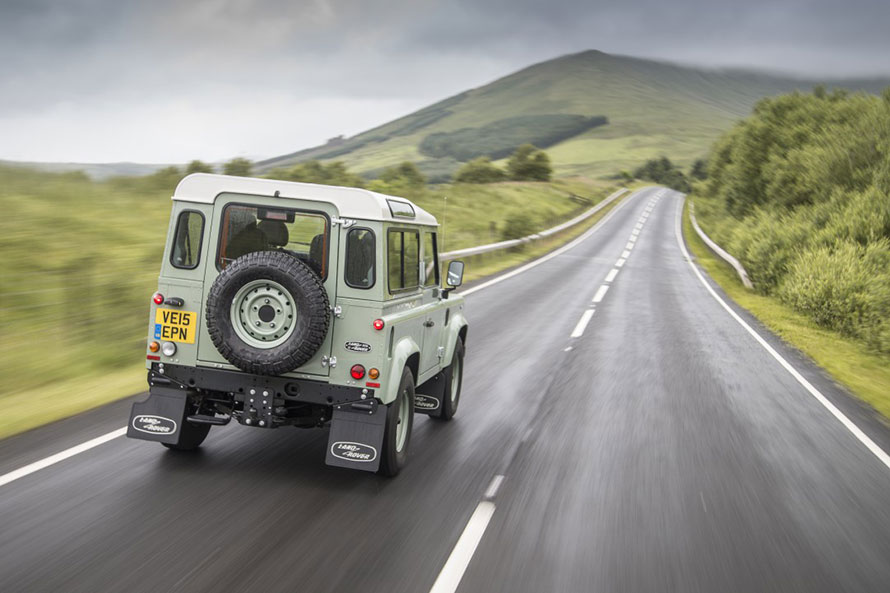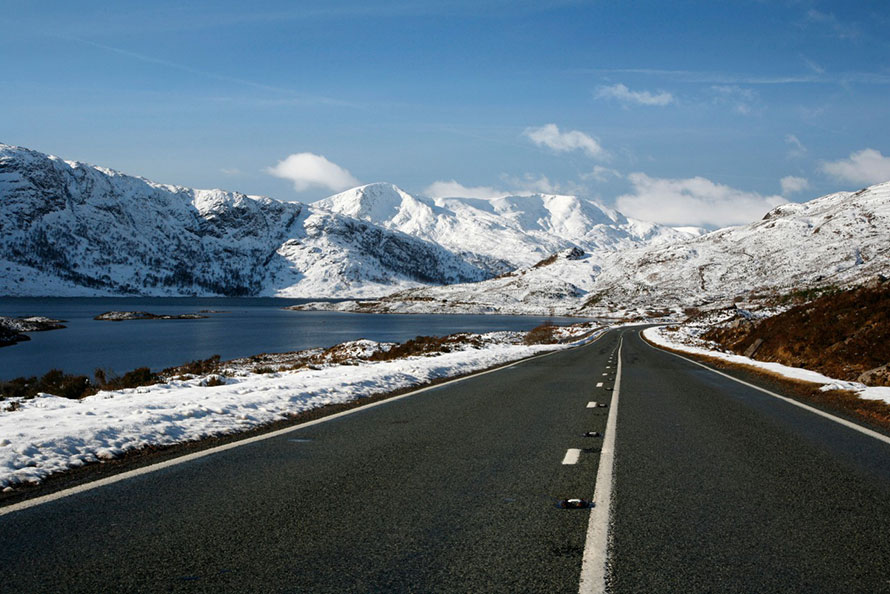The final farewell to the Land Rover Defender
Let’s give this old warhorse one final Highland fling

WHY, I ask myself for the tenth time today, am I driving up an impossibly steep and icy gully 2,000ft up in the Grampians? When I’m not frozen with fear of the near-vertical drop to the Glenshee ski lifts disappearing into the fog below, I’m just frozen. Then I remember: I’m on a merry trip in search of a white Christmas. Talk about taking things to extremes — but extremes are what we’ve been having a lot of lately.
Search for used Land Rover Defenders for sale on driving.co.uk
November and December have been among the warmest on record in Britain. Blame climate change, or possibly the combined hot air of too many international environmental conferences, but you’d be hard pushed to find a white Christmas anywhere in Britain.
After a careful look at weather data — warm fronts across the country — and a topographical search of the highest peaks, I settled on the Scottish Highlands as the likeliest, and possibly the only, destination. Even here there’s precious little of the white stuff. To the dismay of locals, who rely on it for their main business of winter recreation, the usually generous snowfalls have been no more than sprinklings this year. And even when there is snow, getting to it is well-nigh impossible.
Which brings us to the main purpose of this festive exercise: finding a vehicle tough enough to make the ascent to the handful of places with freezing temperatures.
After sifting the options it seems there are only two: a Mercedes Unimog and the vehicle that I’m in — a Land Rover Defender.
“No other car could get you up here,” says Allan Crow, the man I have teamed up with for the climb. “A lot of so-called off-road 4x4s would be bogged down halfway up, or they’d have broken something trying to get across the ditches. In the really wild places there’s nothing to touch the Defender.”
I drive on across a snowy incline a goat would blanch at, and I have to say that nothing feels as willing or as able to take on a ridiculous mountain track
Perhaps he’s swayed by loyalty to the vehicle he owns, but he’s probably right. I drive on across a snowy incline a goat would blanch at, and I have to say that nothing feels as willing or as able to take on a ridiculous mountain track, or gives you as much confidence in a really tight spot, as a Defender. Grinding along in low-ratio second gear, with the vast travel of its independent suspension rising and falling from stop to stop, it surmounts the impossible with unstoppable disdain, all under fingertip control.
Which makes it all the more difficult to explain why Jaguar Land Rover (JLR) is killing off the model. The last Defender rolls off the production line next month. After 68 years one of the world’s most-loved vehicles will slip into history. From Solihull to Seoul, all are in mourning. But even the hardcore aficionados, men such as Crow whose lives revolve around Land Rovers, understand why it had to happen.
“The world moved on and the Defender got left behind. There’s a feeling of sadness and disappointment, but all good things come to an end,” he says.
The Defender has fallen to the health and safety hatchet, and for many reasons. There’s not much give in it: if you hit a pedestrian, you will probably do them serious damage. If you hit anything that can hit back, the stress paths through the vehicle will do you serious damage too. You can’t fit airbags, so for almost 20 years the Defender has been illegal in America, where they’re very strict about these things. The loss of the US market was the first nail in the Defender’s coffin; since that 1997 blow European regulators have conspired to finish the job. The awful emissions made it easy for them.
But it’s not just a case of petty bureaucrats taking down a proud giant. In truth the Defender has feet of clay and sales have been falling off for years. It never really climbed out of the 1950s. The door from a 1958 Series II model would fit the last Defender rolling off the production line next month. On open roads it’s a horrible car — slow, draggy and uncomfortable — and after seven decades Land Rover is still trying to seal the cracks and get the heater to work. The wipers are from a Noddy car, everything rattles and you have to shout so your passenger can hear you.

Yet the Defender has a fanatical fanbase: more than 2m Defenders have been sold to people with inexplicably fond feelings towards their cars. What can possibly explain the mystic communion between a man (and sadly it is largely men) and his Defender?
“Invincibility,” says Douglas Thomson, chairman of the Scottish Land Rover owners’ club, who has nine fine examples. “Whether the sun’s shining or it’s blowing a blizzard, you know your Defender’s going to get you where you need to go in complete safety. There’s not much in life you can bank on, but you can absolutely rely on your Land Rover and your dog.”
Mick Moore, a Cornwall-based independent dealer who has sold thousands of Land Rovers in his time, calls it the ultimate boy’s toy. “It’s like the little wagon you once got for Christmas where all the bits really worked, but you also get to sit in it,” he says. “You and your Defender can go anywhere, from the manure heap to the Dorchester. And when you park next to a Rolls-Royce, nobody will think for a second that you don’t belong there.”
As the Defender’s demise approaches, prices have started to climb. “Second-hand TDI Land Rovers have doubled in price in five years,” says Moore. “And the older ones fetch silly money. I have a 1956 Series I that I bought 20 years ago for £300, and I saw one recently sell for £40,000. I wish I’d kept every one I’ve ever sold.”
Crow’s Defender, which is called Gnasher — he also has Dennis at home — is treated like a living thing
Crow’s Defender, which is called Gnasher — he also has Dennis at home — is treated like a living thing. “It depends on you, and it needs to be looked after,” he says. “There are always little things that need to be done: greasing here, cleaning electrical connections there. You have to be kind to it or it won’t look after you.”
When he says “look after”, he’s speaking figuratively. Halfway up the mountain — and past the point of no return — Crow reveals that he’s had “about 20 rollovers” in Land Rovers such as this and somehow lived to tell the tale. Can you still love it after it’s landed its two-ton bulk on you 20 times?
“Actually, it’s only 19,” says Crow, who quite by chance is still alive at 50. “The other was a BMW 3-series and I was a passenger. And it’s only hurt me really badly once — that was on a club fun day when it rolled five times and I was taken off in the air ambulance with a fractured skull, four broken ribs, a broken shoulder, a shattered elbow and torn ligaments. That’s when the ‘hate’ part of the love-hate relationship with the Defender comes in . . . but time heals everything.”
It’s remarkable that something conceived as a short-term expedient should have captured so many souls and lasted so well. The Defender dates from wartime, when Rover was making bomber engines in Solihull. In 1945 the bottom dropped out of the bomber market and Rover needed to find new work. Steel was rationed, but there was a glut of aircraft-grade aluminium alloy and no end of RAF green cockpit paint.
Maurice Wilks, Rover’s chief engineer, had been running a US army Willys Jeep on his farm in Anglesey and based a new design on it, famously sketching out the first Land Rover on the sands at Red Wharf Bay. It used aluminium alloy and green paint and it would do, he thought, until Rover could get back into making proper cars.
Introduced in 1948 at £450, it was an instant success. Rover realised it had a winner, and other projects were shelved while it developed the Land Rover. Exports at one stage accounted for 80% of production and eventually the firm had 41 assembly plants worldwide.
But as long ago as 1970 Rover admitted the car’s limitations and brought out the Range Rover, complete with creature comforts and a turn of speed. In 1990 the classic Land Rover was relaunched as the Defender, to put clear water between it and the upstart Discovery. In the last 25 years of the Defender’s life engineers applied increasingly desperate tweaks to stay ahead of the emissions sheriff, but it couldn’t go on.

At last we reach the high point, close to the summit of Carn Aosda (3,008ft), 65 miles east of the tallest peak in Britain, Ben Nevis. Even here the snow is thin on the ground compared with in past years. We unscrew a hip flask and share a wee dram and a couple of mince pies. It feels like the end of an era — for white Christmases, that is. The climatologists say, a little gloomily perhaps, that hard winters may never return, because of the upward creep of average temperatures. And, though I may have had a fine old time in Glenshee, it’s not really practical to transport the family to a mountaintop just to get that Christmassy feeling.
As ends of eras go, the future of the Defender looks a little more promising. The bosses at Tata, JLR’s Indian-owned parent company, are ceasing production, but it’s doubtful they will kill off the Defender. There are hundreds of companies making components for it, and the army owns many thousands of Defenders, so parts will not run short in our lifetimes. JLR is discussing a replacement — a “lifestyle” 4×4 to carry on the great traditions of the Defender. But is the Defender replaceable?
“Not as such,” says Crow, as, shivering, we begin our steep descent of the mountain. “Nobody knows what it is that makes the Defender so much more than just a car. But every Defender owner now knows he’s sitting on an appreciating asset, which is a very merry Christmas present for us all.”
Grime doesn’t pay: why Land Rover is on the well-paved road to luxury
Next month will mark the end of the Land Rover Defender — but is it also the end of Land Rover as we know it?
Browse NEW or USED cars for sale on driving.co.uk
For the 68 years the Defender has been in production, it has been the foundation of Land Rover: a lifeline for Arctic treks, jungle expeditions and UN peacekeeping missions, and unmistakeable evidence that the British firm is first and foremost about making rugged vehicles that can explore more of the world than any of its competitors’ machines. This was summed up in the company’s greatest advertising slogan: “The best 4x4xfar”.
When the original Land Rover was created (the Defender name wasn’t used until 1990), simplicity was its goal, from the basic design of the panels — which meant they could be made of aluminium salvaged from Second World War aircraft — to the straightforward and robust four-wheel-drive system. Affordable for farmers, it could be fixed anywhere, whether in the Welsh valleys or a South American village.
That can’t be said of the company’s modern line-up. Farmers no longer pay the bills, and so Land Rover has gone aspirational, launching cars, such as the Range Rover Evoque, that are squarely aimed at urban streets. If you need proof, look no further than its decision to hire Victoria Beckham as a “creative design executive”: she came up with an expensive special-edition Evoque with rose-gold-plated trim. Owners can opt for giant alloy wheels — the sort that cause drivers to avoid raised kerbs for fear of a scratch, let alone the jagged stones of an unmade track.
With this comes the company’s promotion of the Land Rover lifestyle, which appears to involve its cars being driven along empty tarmac roads by a Boden mum and dad on their way from luxury lodge to exclusive ski chalet.
Land Rover has said it will replace the Defender, but few expect the company to return to its roots. Instead, there is talk of sophisticated technology, an eight-speed automatic gearbox and a “premium” interior. Its engineers insist that the company’s cutting-edge technology will carry a Range Rover further through a jungle than a Defender. That may be true, but when part of it breaks you’re unlikely to be able to find a remote tribe with a spare engine software unit. Earlier this year an AA patrol fixed a classic Land Rover’s broken condenser with a potato and cable tie.
It’s clear that Land Rover will struggle to make a car that complies with modern pedestrian safety and emissions regulations without employing complicated and sophisticated technology. It will then have to claw back the development costs of a new car, and has so far done this by selling luxury with a large profit margin. The indications are that it will continue to do the same, ending up with a range of cars that are so competent they can go anywhere, but that may be too expensive for most owners to risk leaving the road.
This approach has so far resulted in burgeoning profits, as well as new factories and jobs for British workers. In the meantime, Toyota’s durable and workmanlike Land Cruiser and Mitsubishi’s Shogun forge through the war zones and wild places that used to be Land Rover’s domain.
Dominic Tobin




